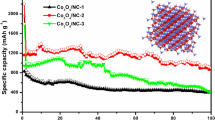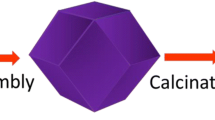Abstract
Transition metal phosphides (TMPs)/carbonaceous matrices have gradually attracted attention in the field of energy storage. In this study, we presented nickel phosphide (Ni2P) nanoparticles anchored to nitrogen-doped carbon porous spheres (Ni2P/NC) by using metal-organic framework-Ni as the template. The comprehensive encapsulation architecture provides closer contact among the Ni2P nanoparticles and greatly improves the structural integrity as well as the electronic conductivity, resulting in excellent lithium storage performance. The reversible specific capacity of 286.4 mA h g−1 has been obtained even at a high current density of 3.0 A g−1 and 450.4 mA h g−1 is obtained after 800 cycles at 0.5 A g−1. Furthermore, full batteries based on LiNi1/3Co1/3Mn1/3O2||Ni2P/NC exhibit both good rate capability and cycling life. This study provides a powerful and in depth insight on new advanced electrodes in high performance energy storage devices.
摘要
过渡金属磷化物(TMPs)/碳复合材料的设计合成在储能领域逐渐引起了研究人员的关注. 本研究以镍基-金属有机骨架材料为模板将磷化镍(Ni2P)纳米颗粒嵌入到氮掺杂碳(Ni2P/NC)多孔微球中. 全面碳封装结构使得Ni2P纳米颗粒之间的接触更加紧密, 大大提高了结构的完整性和导电性, 使得储锂性能更加优异. 即使在电流密度为3.0 A g−1的情况下, 可逆比容量仍可达286.4 mA h g−1. 在0.5 A g−1 电流密度下连续充放电循环800次后, 仍可获得450.4 mA h g−1的可逆比容量. 本研究证实了Ni2P/NC微观结构的可逆性. 此外, 基于LiNi1/3Co1/3Mn1/3O2||Ni2P/NC的全电池展示了良好的速率性能和循环寿命. 本研究为寻找应用于储能装置的先进电极材料提供了有力而深入的理论依据.
Similar content being viewed by others
References
Chu S, Majumdar A. Opportunities and challenges for a sustainable energy future. Nature, 2012, 488: 294–303
Chu S, Cui Y, Liu N. The path towards sustainable energy. Nat Mater, 2017, 16: 16–22
Mei J, Liao T, Kou L, et al. Two-dimensional metal oxide nanomaterials for next-generation rechargeable batteries. Adv Mater, 2017, 29: 1700176
Simon P, Gogotsi Y, Dunn B. Where do batteries end and super-capacitors begin? Science, 2014, 343: 1210–1211
Yu Z, Tetard L, Zhai L, et al. Supercapacitor electrode materials: nanostructures from 0 to 3 dimensions. Energy Environ Sci, 2015, 8: 702–730
Pomerantseva E, Bonaccorso F, Feng X, et al. Energy storage: The future enabled by nanomaterials. Science, 2019, 366: eaan8285
Yu XY, David Lou XW. Mixed metal sulfides for electrochemical energy storage and conversion. Adv Energy Mater, 2018, 8: 1701592
Zhao Y, Wang LP, Sougrati MT, et al. A review on design strategies for carbon based metal oxides and sulfides nanocomposites for high performance Li and Na ion battery anodes. Adv Energy Mater, 2017, 7: 1601424
Liu B, Zhang Q, Jin Z, et al. Uniform pomegranate-like nanoclusters organized by ultrafine transition metal oxide@nitrogendoped carbon subunits with enhanced lithium storage properties. Adv Energy Mater, 2018, 8: 1702347
Sun M, Liu H, Qu J, et al. Earth-rich transition metal phosphide for energy conversion and storage. Adv Energy Mater, 2016, 6: 1600087
Li X, Elshahawy AM, Guan C, et al. Metal phosphides and phosphates-based electrodes for electrochemical supercapacitors. Small, 2017, 13: 1701530
Chen X, Qiu J, Wang Y, et al. Cactus-like iron diphosphide@carbon nanotubes composites as advanced anode materials for lithium-ion batteries. Electrochim Acta, 2018, 259: 321–328
Han F, Zhang C, Yang J, et al. Well-dispersed and porous FeP@C nanoplates with stable and ultrafast lithium storage performance through conversion reaction mechanism. J Mater Chem A, 2016, 4: 12781–12789
Li Q, Ma J, Wang H, et al. Interconnected Ni2P nanorods grown on nickel foam for binder free lithium ion batteries. Electrochim Acta, 2016, 213: 201–206
Feng Y, Zhang H, Mu Y, et al. Monodisperse sandwich-like coupled quasi-graphene sheets encapsulating Ni2P nanoparticles for enhanced lithium-ion batteries. Chem Eur J, 2015, 21: 9229–9235
Lu Y, Wang X, Mai Y, et al. Ni2P/graphene sheets as anode materials with enhanced electrochemical properties versus lithium. J Phys Chem C, 2012, 116: 22217–22225
Lu Y, Wang XL, Ge X, et al. Graphene-wrapped Ni2P materials: a 3D porous architecture with improved electrochemical performance. J Solid State Electrochem, 2014, 18: 2245–2253
Hou S, Xu X, Wang M, et al. Carbon-incorporated Janus-type Ni2P/Ni hollow spheres for high performance hybrid super-capacitors. J Mater Chem A, 2017, 5: 19054–19061
Xie S, Gou J. Facile synthesis of Ni2P/Ni12P5 composite as long-life electrode material for hybrid supercapacitor. J Alloys Compd, 2017, 713: 10–17
Liang H, Xia C, Jiang Q, et al. Low temperature synthesis of ternary metal phosphides using plasma for asymmetric supercapacitors. Nano Energy, 2017, 35: 331–340
Yuan H, Wu M, Zheng J, et al. Empowering metal phosphides anode with catalytic attribute toward superior cyclability for lithium-ion storage. Adv Funct Mater, 2019, 29: 1809051
Wang XD, Cao Y, Teng Y, et al. Large-area synthesis of a Ni2P honeycomb electrode for highly efficient water splitting. ACS Appl Mater Interfaces, 2017, 9: 32812–32819
Henkes AE, Vasquez Y, Schaak RE. Converting metals into phosphides: A general strategy for the synthesis of metal phosphide nanocrystals. J Am Chem Soc, 2007, 129: 1896–1897
Muthuswamy E, Savithra GHL, Brock SL. Synthetic levers enabling independent control of phase, size, and morphology in nickel phosphide nanoparticles. ACS Nano, 2011, 5: 2402–2411
Zhang H, Nai J, Yu L, et al. Metal-organic-framework-based materials as platforms for renewable energy and environmental applications. Joule, 2017, 1: 77–107
Xie Z, Xu W, Cui X, et al. Recent progress in metal-organic frameworks and their derived nanostructures for energy and environmental applications. ChemSusChem, 2017, 10: 1645–1663
Cao X, Tan C, Sindoro M, et al. Hybrid micro-/nano-structures derived from metal-organic frameworks: preparation and applications in energy storage and conversion. Chem Soc Rev, 2017, 46: 2660–2677
Cao X, Zheng B, Shi W, et al. Reduced graphene oxide-wrapped MoO3 composites prepared by using metal-organic frameworks as precursor for all-solid-state flexible supercapacitors. Adv Mater, 2015, 27: 4695–4701
Wang Q, Zou R, Xia W, et al. Facile synthesis of ultrasmall CoS2 nanoparticles within thin N-doped porous carbon shell for high performance lithium-ion batteries. Small, 2015, 11: 2511–2517
Miao X, Yin R, Ge X, et al. Ni2P@carbon core-shell nanoparticlearched 3D interconnected graphene aerogel architectures as anodes for high-performance sodium-ion batteries. Small, 2017, 13: 1702138
Li B, Liu Y, Jin X, et al. Designed formation of hybrid nanobox composed of carbon sheathed CoSe2 anchored on nitrogen-doped carbon skeleton as ultrastable anode for sodium-ion batteries. Small, 2019, 15: 1902881
Fang Y, Xiao L, Ai X, et al. Hierarchical carbon framework wrapped Na3V2(PO4)3 as a superior high-rate and extended lifespan cathode for sodium-ion batteries. Adv Mater, 2015, 27: 5895–5900
Wang X, Chen K, Wang G, et al. Rational design of three-dimensional graphene encapsulated with hollow FeP@carbon nanocomposite as outstanding anode material for lithium ion and sodium ion batteries. ACS Nano, 2017, 11: 11602–11616
Huang L, Cao X, Pan A, et al. Bimetallic phosphides embedded in hierarchical P-doped carbon for sodium ion battery and hydrogen evolution reaction applications. Sci China Mater, 2019, 62: 1857–1867
Yan L, Dai P, Wang Y, et al. In situ synthesis strategy for hierarchically porous Ni2P polyhedrons from MOFs templates with enhanced electrochemical properties for hydrogen evolution. ACS Appl Mater Interfaces, 2017, 9: 11642–11650
Tang C, Zhang R, Lu W, et al. Energy-saving electrolytic hydrogen generation: Ni2P nanoarray as a high-performance non-noblemetal electrocatalyst. Angew Chem Int Ed, 2017, 56: 842–846
Zhu K, Liu J, Li S, et al. Ultrafine cobalt phosphide nanoparticles embedded in nitrogen-doped carbon matrix as a superior anode material for lithium ion batteries. Adv Mater Interfaces, 2017, 4: 1700377
Peng S, Li L, Mhaisalkar SG, et al. Hollow nanospheres constructed by CoS2 nanosheets with a nitrogen-doped-carbon coating for energy-storage and photocatalysis. ChemSusChem, 2014, 7: 2212–2220
Cheng Y, Li Q, Wang C, et al. Large-scale fabrication of core-shell structured C/SnO2 hollow spheres as anode materials with improved lithium storage performance. Small, 2017, 13: 1701993
Wu C, Kopold P, van Aken PA, et al. High performance graphene/Ni2P hybrid anodes for lithium and sodium storage through 3D yolk-shell-like nanostructural design. Adv Mater, 2017, 29: 1604015
Lou P, Cui Z, Jia Z, et al. Monodispersed carbon-coated cubic NiP2 nanoparticles anchored on carbon nanotubes as ultra-long-life anodes for reversible lithium storage. ACS Nano, 2017, 11: 3705–3715
Li G, Yang H, Li F, et al. Facile formation of a nanostructured NiP2@C material for advanced lithium-ion battery anode using adsorption property of metal-organic framework. J Mater Chem A, 2016, 4: 9593–9599
Luo ZZ, Zhang Y, Zhang C, et al. Multifunctional 0D-2D Ni2P nanocrystals-black phosphorus heterostructure. Adv Energy Mater, 2017, 7: 1601285
Chao D, Zhu C, Yang P, et al. Array of nanosheets render ultrafast and high-capacity Na-ion storage by tunable pseudocapacitance. Nat Commun, 2016, 7: 12122
Shen L, Wang Y, Lv H, et al. Ultrathin Ti2Nb2O9 nanosheets with pseudocapacitive properties as superior anode for sodium-ion batteries. Adv Mater, 2018, 30: 1804378
Yang C, Yu S, Lin C, et al. Cr0.5Nb24.5O62 nanowires with high electronic conductivity for high-rate and long-life lithium-ion storage. ACS Nano, 2017, 11: 4217–4224
Zhou D, Fan LZ. Co2P nanoparticles encapsulated in 3D porous N-doped carbon nanosheet networks as an anode for high-performance sodium-ion batteries. J Mater Chem A, 2018, 6: 2139–2147
Li X, Chen G, Le Z, et al. Well-dispersed phosphorus nanocrystals within carbon via high-energy mechanical milling for high performance lithium storage. Nano Energy, 2019, 59: 464–471
Lin X, Wang Y, Chai W, et al. Solvothermal alcoholysis synthesis of hierarchically porous TiO2-carbon tubular composites as highperformance anodes for lithium-ion batteries. Electrochim Acta, 2019, 308: 253–262
Acknowledgements
This work was partly supported by the National Natural Science Foundation of China (11705015 and U1832147), the Foundation of Jiangsu Science and Technology Department (BA2016041), the Science and Technology Plan Project of Suzhou (SYG201738 and SZS201710). We sincerely acknowledge Prof. Augusto Marcelli for polishing the language and the staff of the XAS beamlines of Beijing Synchrotron Radiation Facility for their support on this study.
Author information
Authors and Affiliations
Contributions
Author contributions Tao S and Cui P engineered the experiments and wrote the paper; Chen S performed the XAFS experiments; Qian B and Song L proposed the experimental design and revised paper; Marcelli A polished the manuscript. All authors contributed to the general discussion.
Corresponding authors
Ethics declarations
Conflict of interest The authors declare no conflict of interest.
Additional information
Shi Tao received his PhD degree from the University of Science and Technology of China in 2016. He is currently working as an associate professor in Changshu Institute of Technology. His research focuses on the synthesis of novel electrode materials for application in lithium-ion batteries, sodium-ion batteries and the relationship between structure and property of electrodes using synchrotron radiation technique.
Bin Qian is currently a professor at the School of Electronic and Information Engineering in Changshu Institute of Technology. He received PhD degree from Nanjing University in 2009, Followed by a research stay at Tulane University in USA. His current research interests mainly include the design of novel magnetic materials and energy storage materials for batteries.
Li Song received his PhD in 2006 from the Institute of Physics, Chinese Academy of Sciences (supervised by Prof. Sishen Xie). After four years postdoctoral research at the University of Munich, Germany and Rice University, USA, he became an associate professor at Shinshu University in Japan. He was promoted to professor at the University of Science and Technology of China in 2012. His current research interests are synchrotron radiation study on low dimensional nanostructures and energy-related devices.
Rights and permissions
About this article
Cite this article
Tao, S., Cui, P., Cong, S. et al. Metal-organic framework-derived Ni2P/nitrogen-doped carbon porous spheres for enhanced lithium storage. Sci. China Mater. 63, 1672–1682 (2020). https://doi.org/10.1007/s40843-020-1328-y
Received:
Accepted:
Published:
Issue Date:
DOI: https://doi.org/10.1007/s40843-020-1328-y




